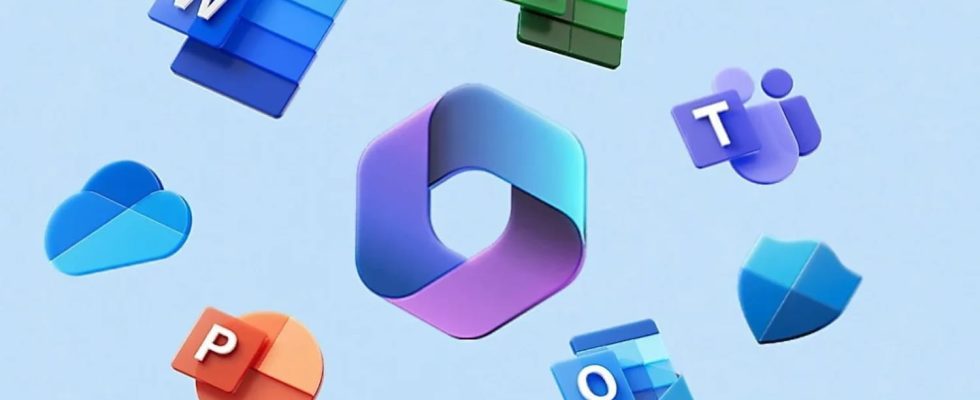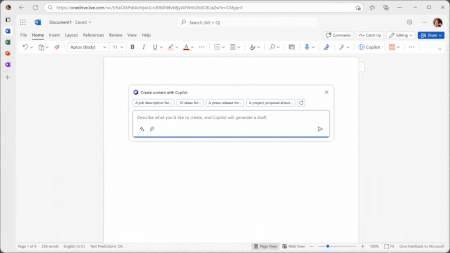Copilot, Microsoft’s AI-powered assistant, is finally making its debut in the Microsoft 365 office suite. A small revolution that should change the lives of users, but whose price will make people cringe!
This time, it’s concrete: Copilot is finally integrated into Microsoft 365 applications and services (Word, Excel, PowerPoint, Outlook, Teams, etc.), with the aim of helping users generate and manage documents, emails or even presentations. Announced last March, the launch of this new assistant using artificial intelligence – it is powered by GPT-4 – has however been a long time coming. The function has been available in Europe and the United States since 1er November 2023 for just under €30 per month per user, for Microsoft 365 E3, E5, Business Standard and Business Premium customers. A sum that must therefore be added to the €37.70 per user per month for Microsoft 365 E3, the €59.70 for the E5, the €11.5 for the Business Standard and the €20.60 for Business Premium . A significant amount! Around 600 enterprise customers, including KPMG, Lumen and Emirates NBD, have been able to test Microsoft 365 Copilot through a paid early access program over the past few months. For the general public, however, no date has been announced, except that everyone will be able to benefit from it in Windows 11. The fact remains that the Redmond firm will have to face fierce competition from Google, which is counting on also integrate AI everywhere in its Workspace suite (see our article).
Microsoft Copilot: an AI that revolutionizes Microsoft 365
Last March, Satya Nadella, president and CEO of Microsoft, declared on the company blog that Copilot “marks the next major step in the evolution of how we interact with computing, which will fundamentally change the way we work and unlock a new wave of productivity growth. With our new co-pilot for work, we are empowering people and making technology more accessible through the most universal interface – natural language.” So, how does Copilot promise to be a real revolution?
For Jared Spataro, head of Microsoft 365, “Copilot is a whole new way of working“. As reported The Verge, the assistant is present in the sidebar in the form of a chatbot and allows users to use it to generate text in documents, create PowerPoint presentations based on Word documents, or even give a helping hand to use functions like pivot tables in Excel. As a reminder, Edge 111 benefits from the same addition, the “Detect” tab having become “Copilot”, a module capable of displaying all the data of a site, offering similar content and texts using the Bing AI.
One of the most interesting uses of Copilot is its ability to generate a PowerPoint presentation of 10 slides (maximum) from a simple Word document. All you have to do is ask him, a bit like you would with a question for ChatGPT, and tell him which document to rely on so that he can take action. See: a few words and a click to generate an entire presentation effortlessly! Then all that remains is to make your modifications. Let’s hope that the result is more successful than with the DesignerBot from Beautiful.ai.
Copilot also looks very promising in other applications in the Microsoft 365 suite. Thus, in Word, the assistant can write documents from other files. The AI-generated text can then be freely edited and adapted. It also allows you to analyze and format Excel data. Handy for instantly creating a SWOT analysis (a business strategy tool) or pivot table – which is tricky for novices. In Teams, Copilot allows you to transcribe meetings, remind the user of elements they might have missed – by arriving late for example – or summarize the actions to be taken throughout a meeting. Note that an extension of the assistant is also present in the Teams call interface and in conversations. Finally, in Outlook, it allows you to sort your emails more quickly and to create draft replies with buttons to adapt the tone or length of the message.
Microsoft Copilot: a system with a Business Chat function
Obviously, with AI, we necessarily fear errors and hallucinations, those moments when they start to do anything. “Sometimes Copilot will be right, other times it will be usefully wrong, giving you an idea that isn’t perfect but still gives you a head start.”, declared Jared Spataro during his conference in March. You should therefore not take your work at face value and remain suspicious. But as much as an error is easily seen in an email, it is more difficult with an Excel table with hundreds of lines!
“To create Copilot, we didn’t just connect ChatGPT to Microsoft 365”explains Jack Spataro. “Microsoft 365 Copilot is powered by what we call the Copilot system. This system combines Microsoft 365 applications such as Word, Excel and PowerPoint with Microsoft Data and Intelligence Graph and GPT-4.“To put it simply, the user’s queries go through the different software and the language model to provide the most reliable and complete answers possible.
The company plans to launch a Business Chat feature, since renamed Windows 365 Chat, which will work using all of Microsoft 365’s data and applications. “It uses the Microsoft Graph to bring together documents, presentations, emails, notes, and contacts into a single chat interface in Microsoft Teams that can generate summaries, planning overviews, and more.” In this way, Copilot has real-time access to content and context stored in the Microsoft Graph. This means that it generates responses based on the user’s work content – their documents, emails, calendar, chats, meetings, contacts and other data – and combines them with their work context – the meeting in progress, e-mail exchanges on a subject, chat conversations had a few days previously – to “provide precise, relevant and contextual answers.” Preview users can now try Chat on Microsoft365.com, Teams, and Bing Browser when signed in to their work account.
Microsoft Copilot: what about data security?
Copilot promises to revolutionize the way we use the office suite. This represents a considerable saving of time and should give a big helping hand to users who do not fully master all the subtleties and functions of Microsoft 365. Note, however, that the Redmond firm’s announcement came just a few days after Google announced similar AI functions for Google Workspace (Gmail, Docs, Sheets…). It’s definitely a war between the two digital giants! However, this speed of innovation and the lack of reliability of its AI models do not fail to raise some concerns, particularly in terms of the security of users’ professional data.
On this point, Microsoft tries to be reassuring. “We clearly explain how the system makes its decisions by stating limitations, cross-referenced sources, and inviting users to review, fact-check, and adjust content based on their subject matter expertise”explained Jack Spataro in a blog post, promising that the AI will not be trained on user data. A statement that leaves us a little skeptical when we know that the company had fired its team dedicated to the ethics of artificial intelligence. Its mission was to identify the risks posed by Microsoft’s adoption of OpenAI language models in its software and services…


